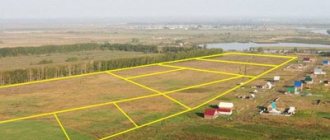Land plot: concept and features
The concept of “land” has a multidimensional nature. Its properties are determined by the forces of nature and correspond to objective laws (ecological approach). Being the territorial basis of economic management and a means of production, land resources have a value expression (economic approach). Land is a specific object of civil rights (legal approach). Within the framework of subsection 3 of the Civil Code of Russia “Objects of civil rights”, the legislator considers land plots. Each of them:
- is part of the earth's surface with a fixed boundary;
- has characteristics that allow them to be identified as an individually defined thing.
The boundaries of the site can:
- be combined with the boundaries of natural geographical objects (river coastline, forest contour);
- coincide with the contours of the elements of the situation (building wall, fence line);
- be an imaginary broken line, the angles of rotation of which are formed by boundary signs, stakes, pins.
Land plots are recognized as negotiable real estate (Articles 139, 140 of the Civil Code of the Russian Federation). Their area, configuration, location and legal status are displayed in the State Real Estate Cadastre (GKN). Transactions with land, ownership and other property rights (easements, encumbrances, mortgages) are recorded in the Unified State Register of Real Estate (USRE).
What is “land allotment formation” and how does it happen?
In essence, the formation of a land territory is the creation of a specific real estate object. Land plots can be formed in two ways:
- Based on those lands that are already in use (they are redistributed, divided or, conversely, combined, allocated).
- When they develop lands that are not used in any way. Namely, from state or urban areas.
The allotment certainly has a strictly fixed boundary, which is indicated in the documents. According to the legislation of the Russian Federation, the creation of a site means its registration in the cadastral register. After it is entered into the register, a corresponding document is issued and a number is assigned to it. The allotment is considered subject to registration as private or other property. Now this site is an object of civil law. And, therefore, can be the object of purchase and sale.
Specified Requirements
Of course, there are a number of conditions without which the formation of a land plot cannot take place. Let's look at them.
- All owners and users of certain areas agree in writing to this. Consent must be verified. This is a mandatory preliminary stage.
- The category of land is determined. If the intended purpose of the original and created areas differs, then they need to be brought to the same form. And only then form the memory.
- Maximum permissible dimensions for plots must be observed. They depend on where it is located and what the purpose of the site is.
- The site should not interfere with the use of existing buildings and the entire territory.
Territory survey project
The named document (abbreviated as PMT) is intended to determine the location of the boundaries of newly formed or changed plots in accordance with urban planning regulations and land allocation norms. Art. 43 of the Urban Planning Code of Russia establishes the need to develop PMT in relation to:
- built-up areas;
- lands subject to development located within the elements of the planning structure (block, microdistrict).
The land surveying project is recognized as an independent part of the territory planning project (PTP). The latter is a comprehensive document establishing the parameters of real estate zones:
- completed construction, put into operation;
- planned for construction;
- the construction of which may be permitted in the future.
The PPT clarifies the data of the general plan of the settlement, reflecting the level of investment attractiveness of the land, including the population size and the estimated volumes of housing, engineering and transport construction. The drawing, which is an integral part of the PPT, contains the so-called “red lines”. At the same time, the document displays the infrastructure of the corresponding territory. It is requested when granting a building permit.
The PMP can be issued as an independent document or be part of a territory planning project. It includes drawings showing:
- "red lines";
- mandatory indentation lines (taken into account when placing buildings);
- conditional numbering of the created plots, their boundaries on the cadastral plan;
- zones of public easements (passage, travel, cattle driving) and special regime for land use;
- boundaries of cultural heritage sites.
The PMT also contains the following information:
- area of created sites;
- zones that, after formation, will receive the regime of public areas;
- in some cases - types of permitted use of created/changed areas.
The procedure for the formation of land plots
The formed land plots must comply with the requirements of civil legislation, land legislation, forestry legislation, water legislation, urban planning legislation and other requirements for land plots established in accordance with the legislation of the Russian Federation.
If, in accordance with federal law, the formation of land plots must be carried out taking into account a territory surveying project, a land plot or land plots survey project, or another document provided for by federal law, the location of the boundaries of these land plots is determined taking into account such a document.
In accordance with current legislation, the formation of land plots is carried out by cadastral engineers by carrying out cadastral work with the subsequent receipt of a cadastral passport for the land plot.
Cadastral work is carried out by a cadastral engineer on the basis of a contract for the performance of cadastral work, concluded in accordance with the requirements of civil legislation and the Federal Law of the Russian Federation “On the State Real Estate Cadastre”.
In cases provided for by the legislation of the Russian Federation, cadastral work can be performed by a cadastral engineer based on a court ruling.
The court is independent in choosing the appropriate cadastral engineer.
Expenses associated with the implementation of cadastral work, as determined by the court, and monetary remuneration to the relevant cadastral engineer are subject to reimbursement and payment in the manner established by the legislation of the Russian Federation.
Layout of the land plot on the cadastral plan
The document is an image of the boundaries of one or more formed plots on the cadastral plan of the territory. The layout of the land plot on the cadastral plan displays the area of each formed plot. The layout of the land plot is developed taking into account urban planning, land management, and environmental documentation.
The preparation of a document before an auction for the right to purchase or lease a land plot is ensured by the executive body of local government or state power.
The layout of a land plot can be prepared at the initiative of an interested citizen or organization.
Preparation for the purpose of subsequent seizure for public needs is provided by the person in whose favor it is seized. In the case of the formation of plots through the redistribution of land intended for farming, gardening and vegetable gardening, the preparation of schemes is ensured by the owners of such plots.
The decision to approve the location plan is approved by the municipality or the competent government authority and is valid for two years. It contains the following information:
- land area;
- address, and in its absence - another description of the location;
- cadastral number;
- land category;
- territorial zone, and if the urban planning regulations do not apply to the site - types of permitted use.
In the event of intersection of the boundaries of plots formed according to the location plan and land surveying project, the first document, as a general rule, has priority. The rule applies if the land surveying project was approved later, and the two-year validity period of the decision to approve the site layout plan has not yet expired at the time of its formation.
If a land plot is formed at the initiative of a citizen or organization, the decision to approve the plot location scheme indicates the right of such a person to register the right of municipal or state ownership of such a plot in the Unified State Register of Enterprises without a power of attorney.
The competent authority that made the decision sends it to the Unified State Register and State Property Committee within five days (meaning business days). As a result, the information specified in the decision and diagram is displayed on publicly available cadastral maps.
Methods for the formation of land plots.
At the legislative level, there are several options for the formation of new plots of land :
- Dividing an existing land plot into an indefinite number of new ones.
- Consolidation of existing plots into a single territory.
- Redistribution of current lands, as a result of which new ones are formed.
- Allocation of a certain territory.
- New land plots are being formed on the territory of the municipality.
It is important to understand that the transformation of a site entails the loss and termination of physical and legal status. Previous territories become documented invalid.
Preparation of design documentation for a forest plot
Design of sites provided for in Art. 70.1 of the Forest Code of the Russian Federation is a key element of forest management. Such activities involve collecting and displaying information about the quantitative and qualitative characteristics of forest areas. The location, area and boundaries of plots are established in accordance with existing forest blocks, forest taxation divisions within forest districts and forest parks. Land legislation is applied subsidiarily to the formation of forest areas adjacent to areas whose boundaries are determined in accordance with Federal Law No. 78 “On Land Management”.
The design documentation of a forest plot, among other things, contains information about the intended purpose and types of permitted use of forest resources in the corresponding territory, for example:
- timber harvesting;
- hunting management;
- scientific, research, educational and recreational activities;
- growing forest planting materials;
- construction, operation of linear facilities.
As a general rule, design documentation is developed by the government or self-government body that has jurisdiction over the site. In case of transfer of land for use or lease, documentation may be prepared at the initiative of the interested party. Subsequently, it is approved by a decision of the body authorized to provide the forest area for use. The validity period of such a decision is two years.
The design documentation of forest areas, among other things, contains the following information:
- area of the site (areas covered with forest vegetation are marked separately);
- type of permitted use according to forestry regulations;
- taxation description of plantings (composition, age, quality, etc.);
- the intended purpose of forests indicating the category;
- cartographic materials.
Who can form a land plot (plots)
This can be done by the following persons who own the original land plot(s):
1) owner (owners) as a general rule.
2) a person with whom an agreement has been concluded on the development of a built-up area, if the land plot is formed from a plot that is located within the boundaries of such a territory;
3) a person with whom an agreement has been concluded on the comprehensive development of the territory, when dividing the site that has been provided to him for this purpose.
Please note that in relation to lands (land plots) that are publicly owned, you can initiate the formation of new land plots from them.
For example you can do this:
- if you need to divide a plot of land that is leased to you (on the right of permanent (perpetual) use or free use);
- for selling a plot or renting it out at auction
Allocation of land
The allocation of a land share (shares) is permitted in cases where there is a right of common shared ownership in relation to the original plot. In this case, after separation, one or more new sections are formed. The original land plot retains its existence within the changed boundaries.
The ownership right of the person who submitted the application for the allocation of a land share arises in the new plot. In this case, his right of common shared ownership of the original plot is terminated.
A typical case when the need to allocate a land share arises is the lack of consent of shareholders on the use of a common land plot. In the absence of the consent of the remaining shareholders to allocate the share in kind, the applicant has the right to demand the allocation in court. If the plot is indivisible and the allocation of a share in kind is impossible, the applicant has the right to have the cost of the share paid to him at the expense of the remaining shareholders.
There are specific features for allocating a land share from agricultural land. In this case, the decision to form a new plot by allocating the land share is made by the general meeting of participants in the common shared ownership, and if there is no such decision, the applicant has the right to contact a cadastral engineer to carry out land surveying of a new plot for subsequent allocation.
The size of the allocated share is determined in accordance with the data of the title documents for the allocated shares. The area of the newly formed plot in this case may be more or less than the standard one, depending on the physical and qualitative properties of the land. Disputes regarding the area of newly formed plots are resolved by agreement of the shareholders of the original plot, and in the absence of agreement - in court.
Allocation of state or municipal property from land is not allowed, since in this case the original plots do not have a registered right of common shared ownership. The formation of a plot of land from state or municipal property is carried out by forming the plot in the process of its surveying and cadastral registration.
Author of the article
Kuznetsov Fedor Nikolaevich
More than 15 years of experience in the legal field; Specialization – resolution of family disputes, inheritance, property transactions, disputes over consumer rights, criminal cases, arbitration processes.






